The increase in core body temperature in response to exertional-heat stress can predict exercise-induced gastrointestinal syndrome
- PMID: 38577295
- PMCID: PMC10989703
- DOI: 10.1080/23328940.2023.2213625
The increase in core body temperature in response to exertional-heat stress can predict exercise-induced gastrointestinal syndrome
Abstract
Utilizing metadata from existing exertional and exertional-heat stress studies, the study aimed to determine if the exercise-associated increase in core body temperature can predict the change in exercise-induced gastrointestinal syndrome (EIGS) biomarkers and exercise-associated gastrointestinal symptoms (Ex-GIS). Endurance-trained individuals completed 2 h of running exercise in temperate (21.2-30.0°C) to hot (35.0-37.2°C) ambient conditions (n = 132 trials). Blood samples were collected pre- and post-exercise to determine the change in gastrointestinal integrity biomarkers and systemic inflammatory cytokines. Physiological and thermoregulatory strain variables were assessed every 10-15 min during exercise. The strength of the linear relationship between maximal (M-Tre) and change (Δ Tre) in rectal temperature and EIGS variables was determined via Spearman's rank correlation coefficients. While the strength of prediction was determined via simple and multiple linear regression analyses dependent on screened EIGS and Ex-GIS confounding factors. Significant positive correlations between Tre maximum (M-Tre) and change (Δ Tre) with I-FABP (rs = 0.434, p < 0.001; and rs = 0.305, p < 0.001; respectively), sCD14 (rs = 0.358, p < 0.001; and rs = 0.362, p < 0.001), systemic inflammatory response profile (SIR-Profile) (p < 0.001), and total Ex-GIS (p < 0.05) were observed. M-Tre and Δ Tre significantly predicted (adjusted R2) magnitude of change in I-FABP (R2(2,123)=0.164, p < 0.001; and R2(2,119)=0.058, p = 0.011; respectively), sCD14 (R2(2,81)=0.249, p < 0.001; and R2(2,77)=0.214, p < 0.001), SIR-Profile (p < 0.001), and total Ex-GIS (p < 0.05). Strong to weak correlations were observed between M-Tre and Δ Tre with plasma concentrations of I-FABP, sCD14, SIR-Profile, and Ex-GIS in response to exercise. M-Tre and Δ Tre can predict the magnitude of these EIGS variables and Ex-GIS in response to exercise.
Keywords: Exertional; I-FABP; endotoxin; endurance; gastrointestinal symptoms; heat; inflammatory cytokines; thermoregulation.
© 2023 The Author(s). Published by Informa UK Limited, trading as Taylor & Francis Group.
Conflict of interest statement
No potential conflict of interest was reported by the authors.
Figures
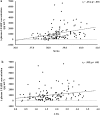
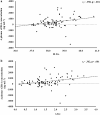
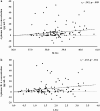
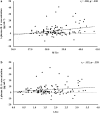

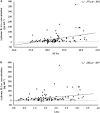
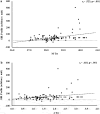
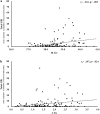
Similar articles
-
The impact of exercise modality on exercise-induced gastrointestinal syndrome and associated gastrointestinal symptoms.J Sci Med Sport. 2022 Oct;25(10):788-793. doi: 10.1016/j.jsams.2022.07.003. Epub 2022 Jul 12. J Sci Med Sport. 2022. PMID: 35868987 Clinical Trial.
-
Gastrointestinal Assessment and Therapeutic Intervention for the Management of Exercise-Associated Gastrointestinal Symptoms: A Case Series Translational and Professional Practice Approach.Front Physiol. 2021 Sep 7;12:719142. doi: 10.3389/fphys.2021.719142. eCollection 2021. Front Physiol. 2021. PMID: 34557109 Free PMC article.
-
The impact of exertional-heat stress on gastrointestinal integrity, gastrointestinal symptoms, systemic endotoxin and cytokine profile.Eur J Appl Physiol. 2018 Feb;118(2):389-400. doi: 10.1007/s00421-017-3781-z. Epub 2017 Dec 12. Eur J Appl Physiol. 2018. PMID: 29234915 Clinical Trial.
-
Exertional-heat stress-associated gastrointestinal perturbations during Olympic sports: Management strategies for athletes preparing and competing in the 2020 Tokyo Olympic Games.Temperature (Austin). 2019 May 7;7(1):58-88. doi: 10.1080/23328940.2019.1597676. eCollection 2020. Temperature (Austin). 2019. PMID: 32166105 Free PMC article. Review.
-
The Effect of Gut-Training and Feeding-Challenge on Markers of Gastrointestinal Status in Response to Endurance Exercise: A Systematic Literature Review.Sports Med. 2023 Jun;53(6):1175-1200. doi: 10.1007/s40279-023-01841-0. Epub 2023 Apr 15. Sports Med. 2023. PMID: 37061651 Free PMC article.
Cited by
-
Physiological response to exercise in the heat: Implications for risk mitigation and adaptation.Temperature (Austin). 2024 Nov 20;12(1):71-84. doi: 10.1080/23328940.2024.2431402. eCollection 2025. Temperature (Austin). 2024. PMID: 40041159
-
Sports Dietitians Australia and Ultra Sports Science Foundation Joint Position Statement: A Practitioner Guide to the Prevention and Management of Exercise-Associated Gastrointestinal Perturbations and Symptoms.Sports Med. 2025 May;55(5):1097-1134. doi: 10.1007/s40279-025-02186-6. Epub 2025 Apr 7. Sports Med. 2025. PMID: 40195264 Free PMC article.
-
Nourishing Physical Productivity and Performance On a Warming Planet - Challenges and Nutritional Strategies to Mitigate Exertional Heat Stress.Curr Nutr Rep. 2024 Sep;13(3):399-411. doi: 10.1007/s13668-024-00554-8. Epub 2024 Jul 12. Curr Nutr Rep. 2024. PMID: 38995600 Free PMC article. Review.
-
The Impact of a 24-h Low and High Fermentable Oligo- Di- Mono-Saccharides and Polyol (FODMAP) Diet on Plasma Bacterial Profile in Response to Exertional-Heat Stress.Nutrients. 2023 Jul 29;15(15):3376. doi: 10.3390/nu15153376. Nutrients. 2023. PMID: 37571312 Free PMC article. Clinical Trial.
-
Impact of moderate environmental heat stress during running exercise on circulating markers of gastrointestinal integrity in endurance athletes.Physiol Rep. 2025 Apr;13(7):e70305. doi: 10.14814/phy2.70305. Physiol Rep. 2025. PMID: 40170530 Free PMC article.
References
-
- Gaskell SK, Lis DM, Costa RJS.. Exercise-Induced Gastrointestinal Syndrome. (Chapter 21. 6th. L Burke, Deakin V, Minehan M., Ed. In: Sydney, NSW, Australia: Clinical Sports Nutrition; McGraw-Hill Education; 2021. pp. 551–575
-
- Gill SK, Teixeira A, Rama L, et al. Circulatory endotoxin concentration and cytokine profile in response to exertional-heat stress during a multi-stage ultra-marathon competition. Exerc Immunol Rev. 2015;21:114–128. - PubMed
-
- Young P, Russo I, Gill P, et al. Reliability of pathophysiological markers reflective of exercise-induced gastrointestinal syndrome (EIGS) in response to prolonged strenuous exercise: a comprehensive methodological efficacy exploration. Frontiers Physiol. 2023;14. In press, DOI:10.3389/fphys.2023.1063335 - DOI - PMC - PubMed
LinkOut - more resources
Full Text Sources
Research Materials
